

What is TTL flash? A jargon-free guide for photographers. What is TTL flash?
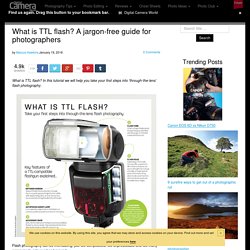
In this tutorial we will help you take your first steps into ‘through-the-lens’ flash photography. Flash photography can be intimidating; just too complicated, too unpredictable and too many acronyms to get your head around. But getting to grips with it can give your photography an edge, whether you’re using a subtle blip of pop-up flash to brighten up shadows in a portrait or setting up multiple off-camera flashguns to illuminate an entire scene. The flash exposure is affected by four key factors: the power of the flash, the distance it is from the subject, the aperture, and the ISO. In manual flash mode, you decide how to manage these settings; but in TTL (through-the-lens) flash mode, the camera measures the brightness of the flash being reflected by the scene into the lens, and automatically adapts the power to produce what it determines is a good exposure.
What is autofocus? Your camera's AF options explained. Do you find your camera’s complex AF options confusing?

We get back to basics and answer the question, ‘What is autofocus anyway?’ In full and jargon-free. All images by Marcus Hawkins. How To: Shoot an In-Camera Double Exposure Photo. Exposure compensation: how your meter gets it wrong and what you can do about it. Your camera’s metering system is a powerful and intelligent tool.

But it doesn’t always get it right. In our latest photography cheat sheet we reveal how your camera can be easily fooled, what exposure compensation function is and how this function can rescue your images. One of the most crucial things to understand about exposure is how your camera measures light. Get to grips with this and all your exposure anxieties should disappear in a flash.
In essence your camera is trying to make everything a mid-tone grey, so if you take a piece of white card and photograph it with the exposure your camera recommends the image should appear grey. Likewise, if you photograph a piece of black card it too should appear grey. Of course, no scene you’re ever likely to photograph is going to be one tone, it’s probably to be made up lots of areas of bright and dark tones and colours.
Exposure compensation explained: download our cheat sheet Click on the infographic to see the larger version. Multiple exposures in-camera: how to get long-exposure effects in bright light. We often sing the praises of camera filters and the creative advantages they offer photographers, but depending on the make and model of your camera, you don’t always need a filter.
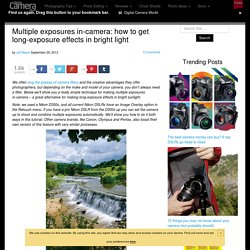
Below we’ll show you a really simple technique for making multiple exposures in-camera – a great alternative for making long-exposure effects in bright sunlight. Note: we used a Nikon D300s, and all current Nikon DSLRs have an Image Overlay option in the Retouch menu. Camera metering and exposure explained. The first step to getting better exposures is to understand how your camera’s metering system interprets a scene.
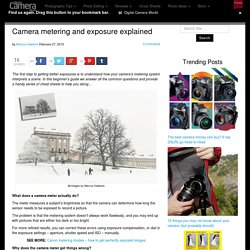
How to Trigger an Off-Camera Flash with the Pop-up Flash. If you have ever wanted to explore off-camera flash but don’t know where to start, I have some good news.
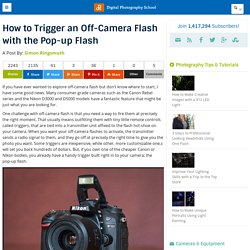
Many consumer-grade cameras such as the Canon Rebel series and the Nikon D3000 and D5000 models have a fantastic feature that might be just what you are looking for. One challenge with off-camera flash is that you need a way to fire them at precisely the right moment. That usually means outfitting them with tiny little remote controls called triggers, that are tied into a transmitter unit affixed to the flash hot-shoe on your camera. When you want your off-camera flashes to activate, the transmitter sends a radio signal to them, and they go off at precisely the right time to give you the photo you want. Some triggers are inexpensive, while other, more customizable one,s will set you back hundreds of dollars. How to take good photos: 10 simple ways to boost your hit rate. Shooting sports: JPEG images or raw format - which should you use?
We all know the benefits of shooting raw format.

In most situations you’ll find yourself, it will be more beneficial to shoot raw files. But when shooting sports, JPEG images offer a significant advantage. In our latest photography cheat sheet we explain how. Your camera uses an internal memory ‘buffer’ to store images taken in continuous shooting mode, and RAW files, which are large, fill it up much more quickly. Angle of view: how to choose the right focal length to frame your image. When framing a photograph, it’s not just the focal length that matters.
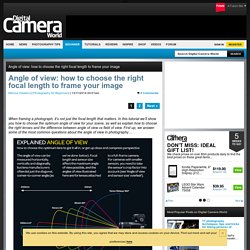
In this tutorial we’ll show you how to choose the optimum angle of view for your scene, as well as explain how to choose the right lenses and the difference between angle of view vs field of view. First up, we answer some of the most common questions about the angle of view in photography… Click on the infographic to see the larger version. Back-button AF: how to master this professional time-saver. Avoid switching between AF modes and ensure sharp images with this clever back button focus technique.
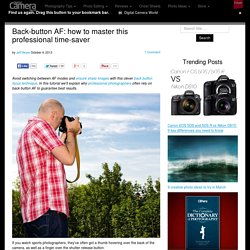
In this tutorial we’ll explain why professional photographers often rely on back button AF to guarantee best results. If you watch sports photographers, they’ve often got a thumb hovering over the back of the camera, as well as a finger over the shutter release button. This is back-button focusing, a technique that keeps autofocus locked on a moving subject; locks focus on a stationary subject and recomposes; or keeps focus on a subject if something else enters the frame. Getting Sharper Images - an Understanding of Focus Modes. The longer you shoot, the larger the repertoire of subjects and assignments you photograph becomes.

You start off photographing flowers in the garden, your neighbour’s dog, your sister’s kids, your friend’s wedding and then before you know it you’re doing product shots for your friend’s new company. All this happens over time and there is one pretty fundamental skill that must remain paramount throughout out your process, properly focused images. 15 of the Best Cheat Sheets, Printables and Infographics for Photographers. Everyone loves cheat sheets, and photographers are no exception. Squeezed into a set of short tips, schemes, and definitions, a cheat sheet is a quick way to learn something, as well as refresh your knowledge about any particular subject. Moreover, now that infographics are an extremely popular format of delivering information on the Internet, cheat sheets can also be a source for visual inspiration. Here is a large collection of some noteworthy cheat sheets, infographics, and printables for photographers.
From shooting basics to photography marketing tips, every aspect of photography is covered in this round-up. No matter whether you’re an amateur or an experienced professional, below you can find some really helpful resources, all presented as easy-to-read checklists, infographics, and printable cheat sheets for your advantage. Enjoy this compilation and don’t forget to bookmark this page for quick access to this exhaustive cheat sheet list. Digital-photography-school. 17 things you can do to help your camera live longer. Your DSLR will deliver years of hassle-free photography, as long as you’re prepared to look after it.
With that in mind, here are 17 simple tips for how to protect your digital camera and make it live longer. Some are recommended camera care routines that many of us in all truth probably don’t carry out as often as we probably should, while other tips offer less obvious ways to extend the life of a camera, particularly if you’re a photography beginner. 1. Do… Read the camera manual. 3 camera lessons every new photographer should learn (free cheat sheet) If you’ve just bought your first camera, you’re probably finding a bit of a learning curve in getting up to speed with all of its bells and whistles. There are a number of great beginner photography tutorials out there that can help you get to grips with all that functionality. Before you get you get started, though, there are three fundamental concepts you need to understand: how your camera’s shutter speed scale works; how focal length affects your composition; and how your aperture controls what’s sharp.
We’ve explained each of these concepts below, and we’ve also compiled everything into a handy photography cheat sheet for you to download and save! White balance explained: how cameras correct the color of different types of light. The White Balance setting you choose will change the colour balance in your pictures, making it warmer or cooler depending on how the sort of light you’re shooting in affects things. Using Auto White Balance is the simple option, but your camera’s White Balance presets give you more control over colour. In this tutorial we’ll explain exactly how these work and how to fine-tune your white balance settings to ensure the most accurate colours possible.
Click on the infographic to see the larger version, or drag and drop to your desktop to save. The colour of the light will affect the colours in your photographs. You probably won’t notice this with the naked eye because our minds adapt very quickly to perceive the colour of the light as neutral, even when it’s not. The camera is less forgiving, and records colours exactly as they are. Digital cameras have ‘White Balance’ controls to correct these colour shifts. Avoid dull landscape photography: simple in-camera tricks to add a feeling of depth. Pin It! You can do almost anything on the computer these days. And while we certainly extol the virtues of the digital darkroom, there is a sense of satisfaction in achieving a desired effect in-camera.
What is Reciprocal Rule in Photography? One of the biggest challenges that many photographers face is yielding sharp photos when hand-holding a camera. Many end up with blurry images without understanding the source of the problem, which is usually camera shake. Unfortunately, camera shake can come from a variety of different sources – from basic improper hand-holding techniques to mirror and shutter-induced vibrations that can be truly challenging and sometimes even impossible to deal with.
How to change your Nikon DSLR settings in an instant. Pin It! Nikon cameras have got a lot cleverer over the years, but they have also got a lot more complex. Look down the list of menu options that you have on your SLR and there are literally thousands of different permutations for how you could set up your camera. Of course, you can ignore most of these options, but some are very useful for specific types of shot.
Customising the autofocus is much more important with action subjects, for instance, than if you are a landscape specialist. How camera flash works: free photography cheat sheet. There is a time and a place for flash photography. It will often kill the atmosphere at a party, but there are other times when your camera flash is the essential ingredient for a successful shot. 21 Settings, Techniques and Rules All New Camera Owners Should Know. Some are very basic while others go a little deeper – but all have been selected from our archives specifically for beginners and new camera owners.
Enjoy. 35 things photographers do wrong (and how to stop doing them) Sensor Size, Perspective and Depth of Field. A few months ago we wrote an extensive article on sensor crop factors and equivalence. In that post we covered several topics: the history of the cropped-sensor formats, brightness of the scene, perspective, depth of field, noise and diffraction. Angle of view: how to choose the right focal length to frame your image. What is normal lens/standard lens? Sigma 50mm on Fujifilm APSC Sometimes, we may have heard of notions like normal lens and standard lens. How to spot meter: an easy guide to measuring precise exposures. 17 things you can do to help your camera live longer. Rescisão de contrato de trabalho por parte do trabalhador - E-Konomista. Contrariamente ao que acontece na rescisão de contrato por iniciativa do empregador, a lei confere maior abertura na rescisão de contrato de trabalho por parte do trabalhador. A cessação de contrato, nestes casos, pode ser com justa causa ou sem justa causa.
Ainda assim, existem obrigações legais a cumprir. Vamos saber mais. Rescisão de contrato com justa causa A entidade empregadora não procede, de forma culposa, ao pagamento pontual da retribuição na forma devida;A empresa viola indevidamente as garantias legais ou convencionais do trabalhador;É aplicada uma sanção abusiva;Não é garantida as condições de higiene e segurança no trabalho;A entidade empregadora lesa de forma culposa os interesses patrimoniais sérios do trabalhador;Quando são dirigidas ofensas à integridade física, liberdade, honra ou dignidade do trabalhador, puníveis por lei, praticadas pela entidade empregadora ou seus representantes legítimos.
Urban photography: how to blur people in busy city scenes. Active D-Lighting: how to make your Nikon capture more detail in shadows and highlights. How to take an exposure reading on your digital camera. 15 of the Best Cheat Sheets, Printables and Infographics for Photographers. What is maximum aperture? Which lenses go widest (and why it matters)
Hyperfocal focusing: how to calculate the best distance to focus at. What is maximum aperture? Which lenses go widest (and why it matters) 3 camera lessons every new photographer should learn (free cheat sheet)